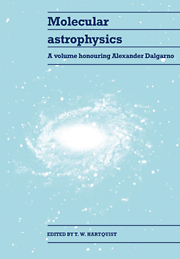Book contents
- Frontmatter
- Contents
- Dedication
- Preface
- Part I Molecular clouds and the distribution of molecules in the Milky Way and other galaxies
- Part II Diffuse molecular clouds
- Part III Quiescent dense clouds
- 6 Chemical modelling of quiescent dense interstellar clouds
- 7 Interstellar grain chemistry
- 8 Large molecules and small grains in astrophysics
- Part IV Studies of molecular processes
- Part V Atomic species in dense clouds
- Part VI H2 in regions of massive star formation
- Part VII Molecules near stars and in stellar ejecta
- Part VIII Moderately ionized gas and chemistry at large redshifts
- Index
8 - Large molecules and small grains in astrophysics
Published online by Cambridge University Press: 10 December 2009
- Frontmatter
- Contents
- Dedication
- Preface
- Part I Molecular clouds and the distribution of molecules in the Milky Way and other galaxies
- Part II Diffuse molecular clouds
- Part III Quiescent dense clouds
- 6 Chemical modelling of quiescent dense interstellar clouds
- 7 Interstellar grain chemistry
- 8 Large molecules and small grains in astrophysics
- Part IV Studies of molecular processes
- Part V Atomic species in dense clouds
- Part VI H2 in regions of massive star formation
- Part VII Molecules near stars and in stellar ejecta
- Part VIII Moderately ionized gas and chemistry at large redshifts
- Index
Summary
Introduction
There is an increasing body of evidence for a population of large molecules in the interstellar medium. Large molecules have been suggested as the source of near infrared continuum radiation and the near infrared emission bands observed in reflection nebula, planetary nebula, HII regions and active galaxies (Duley and Williams 1981, Léger and Puget 1984, Allamandola, Tielens and Barker 1985, d'Hendecourt et al. 1986, Barker, Allamandola and Tielens 1987). Large molecules have also been proposed as the carriers of the diffuse interstellar bands (vander Zwet and Allamandola 1985, Léger and d'Hendecourt 1985, Crawford, Tielens and Allamandola 1985). The large molecules proposed have between 30 and 100 atoms with suggested abundances in the range 10−7−10−6 relative to hydrogen.
Mathis, Rumpl and Nordsieck (1977; MRN) determined a size distribution for grains that would fit the extinction measured to many sources. However, existing extinction measurements do not extend far enough into the ultraviolet to infer the population of the smallest grains. An extrapolation of the MRN distribution to very small grains having between 30 and 100 atoms gives an abundance roughly the same as that proposed for the large molecules, suggesting that the large molecules may be an extension of the interstellar grain distribution.
It appears that a population of small grains or large molecules exists in much of the interstellar medium. We will use the terms large molecules and small grains interchangeably to refer to clusters of between 30 and 100 atoms.
- Type
- Chapter
- Information
- Molecular AstrophysicsA Volume Honouring Alexander Dalgarno, pp. 148 - 156Publisher: Cambridge University PressPrint publication year: 1990

